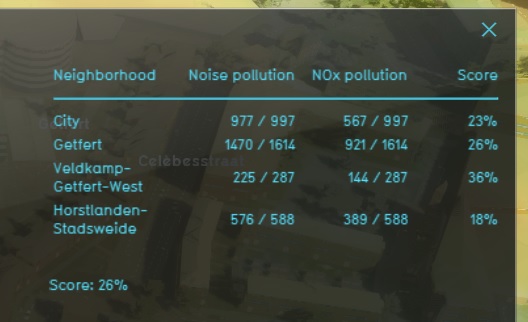Traffic health impact (Indicator): Difference between revisions
Jump to navigation
Jump to search
(Created page with "{{learned|what the traffic health impact indicator is|how the traffic health impact indicator is calculated|how to adjust your project in order to make the indicator functiona...") |
mNo edit summary |
||
| Line 2: | Line 2: | ||
==General== | ==General== | ||
The traffic health impact indicator provides a combined output for the built-in calculated overlays for traffic noise emissions and traffic NOx emissions. It calculates an absolute score based on the percentage of housing units suffering from either form of disturbance. This indicator can be used in project which deal with: | The traffic health impact indicator provides a combined output for the built-in calculated overlays for traffic noise emissions and traffic NOx emissions. It calculates an absolute score based on the percentage of housing units suffering from either form of disturbance. This indicator can be used in project which deal with: | ||
* health and livability considerations | * health and livability considerations | ||
| Line 16: | Line 15: | ||
* The score per neighborhood | * The score per neighborhood | ||
{{clear}} | {{clear}} | ||
===Calculation=== | |||
The indicator counts the total amount of housing units, and the amount of housing units that are affected by either noise or NOx emissions from traffic. | |||
===Score=== | |||
The score of the indicator is the average of | |||
===Additional configurations=== | |||
Revision as of 10:59, 15 March 2019
General
The traffic health impact indicator provides a combined output for the built-in calculated overlays for traffic noise emissions and traffic NOx emissions. It calculates an absolute score based on the percentage of housing units suffering from either form of disturbance. This indicator can be used in project which deal with:
- health and livability considerations
- development of housing solutions
- traffic flow adjustments
Indicator panel
The indicator panel shows the following information:
- The name of the neighborhood
- The amount of houses (related to the total amount of houses) which have more than 50.3 dB of noise.
- The amount of houses (related to the total amount of houses) which have more than 1 ug/m3 of NOx impact.
- The score per neighborhood
Calculation
The indicator counts the total amount of housing units, and the amount of housing units that are affected by either noise or NOx emissions from traffic.
Score
The score of the indicator is the average of
